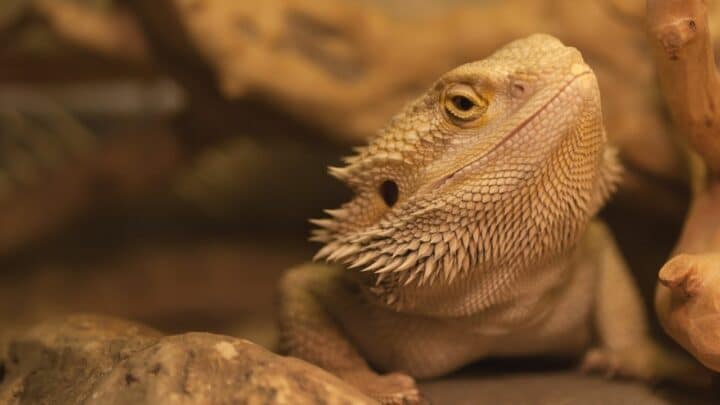I’m not really a reptile person, but my 8-year-old daughter is quite obsessed with them. She kept pleading for a reptile pet for Christmas.
Since I believe that having a pet (or two) teaches kids about commitment and responsibility, I researched to see what would be a good entry-level reptile pet for her.
The answer was a baby bearded dragon (aka beardie). They are hardy pets, easy to care for (while still teaching my daughter the lessons I wanted her to learn), and pretty laid-back.
I quickly dove into research as I wanted to know what beardies eat (and whether I could afford this pet).
One question that kept popping up was that about mealworms (also called superworms) and baby beardies, and whether these are safe to feed them.
I decided to call my exotic pet vet to find out, and this is what he had to say:
How Many Mealworms to Feed a Baby Bearded Dragon?
Never give mealworms to your baby bearded dragon. Mealworms are high in fat, meaning your beardie will put on weight and not get the nutrients it needs to grow. Also, mealworms don’t have adequate calcium to phosphorus ratio. The size of the mealworm can also cause internal blockages, impaction, and death.
Weighing up the Pros and Cons of Feeding Mealworms to a Baby Beardie
The larvae of beetles are called mealworms.
As food for lizard pet owners, these have several advantages:
- Easily stored
- They are easy to breed, making this an affordable food source for your lizard or beardie.
- If you need to buy mealworms, they are readily available in pet stores and online suppliers.
- They are a tasty treat.
However, there is more you need to know about mealworms before we consider whether this is a safe food option for a baby beardie.
High in Fat and Protein = Overweight and Unhealthy
The nutrient composition of mealworms is as follows:
- Carbohydrates: 3%
- Fat: 14%
- Ash: 1%
- Protein: 19%
- Moisture: 63%
While mealworms are relatively high in protein, they have nearly equally as much fat. This isn’t ideal as your beardie will suffer from malnutrition if they are fed on a diet of mealworms.
Moreover, they will quickly become overweight, which means your beardie will be unhealthy.
Bad Calcium to Phosphorus Ratio
When you have a bearded dragon, looking at the calcium to phosphorus ratio in their foods (insects and veggies alike) is crucial.
Calcium is an important nutrient as it promotes healthy bone development, muscle contractions, and good reproductive health in female beardies.
Beardies need both calcium and vitamin D. The latter helps them absorb the former.
But too much phosphorus prevents vitamin D from doing its job, which in turn, means that calcium isn’t properly absorbed.
Ideally, the calcium to phosphorus for your beardie should be 1.5:1 or 2:1. Mealworms’ calcium to phosphorus ratio is 0.33:1, which is far too low.
Thus, mealworms should never be a major part of a beardie’s diet.
The Hard Shell
A big disadvantage of mealworms is their hard shell. This makes the superworm difficult to bite and chew.
For baby beardies, this tough exoskeleton is a big no-no.
The Chitin Coating
Mealworms have a chitin coating, which is insoluble fiber. However, baby beardies should not eat chitin-coated insects as it makes the insect difficult to chew and digest.
Your beardie could become ill with impaction.
The Size
If you buy your mealworms from the pet store, you’ll find that these are half an inch long.
This means that they are too big for baby beardies to swallow and it can cause internal blockages, which need veterinary treatment.
If the blockage is particularly bad, your beardie will need surgery, which is expensive.
Impaction can also happen. This is when your beardie’s digestive system is blocked by a semi-solid or solid mass, and your beardie won’t be able to poop.
So yes, it is constipated — badly!
With the baby bearded dragon not being able to pass this mass, it puts pressure on their spinal cord, and eventually, your beardie can die.
The Fight: Mealworm vs Baby Beardie
Mealworms are quite vicious. When a beardie hunts them at feeding time, the superworm will use stringing and biting tactics to try to survive.
Baby beardies are timid hunters, so a mealworm that’s aggressive may be too much for your beardie.
It won’t be able to attack and eat the mealworm as an adult bearded dragon would.
Frequently Asked Questions about How Many Mealworms to Feed a Baby Bearded Dragon
What’s the ideal feeding schedule for a baby bearded dragon?
Your baby beardie (under 3 months) should be fed 4-5 times per day, so they eat more often than an adult bearded dragon. Once your beardie is 3-6 months old, they should eat 3-4 times a day, while beardies older than 6 months should eat 3 times a day.
How much food should I feed my 2-month-old bearded dragon?
A beardie that’s 2 months old should be eating between 20-40 crickets per day as well as a good mix of veggies. 80% of their diet should be feeder insects, like crickets, while the remaining 20% should be vegetables, like kale, mustard greens, carrots, squash, pumpkin, parsnips, and collard greens.
The Final Beardie
I was grateful I could chat with my local exotic vet about baby beardies and their dietary requirements.
Now I could teach my daughter all about baby bearded dragons, what they need in their tank, and what they need to eat (and not eat).
As her baby beardie grows, we’ll regularly check in with the exotic vet to make sure the bearded dragon’s needs are fully met so it can thrive and live a long and happy life.


